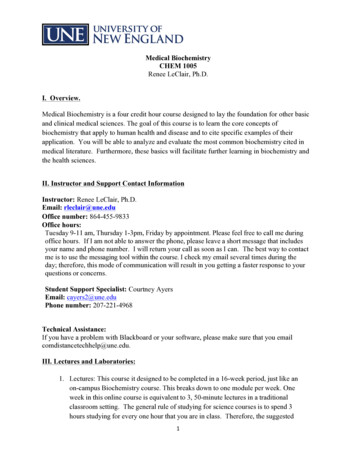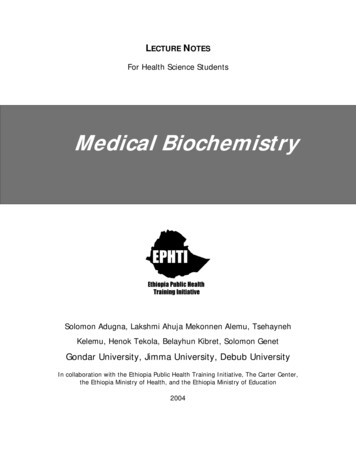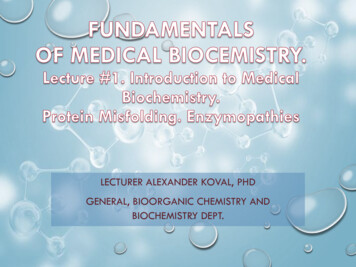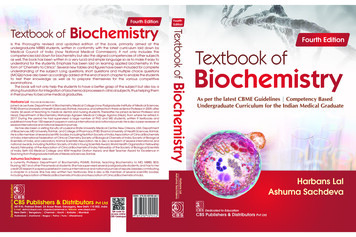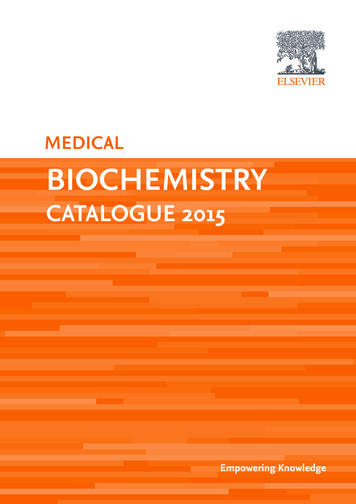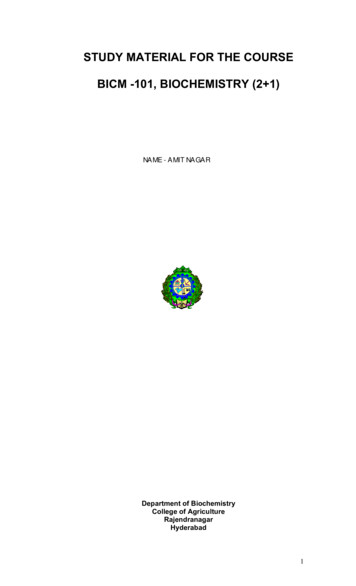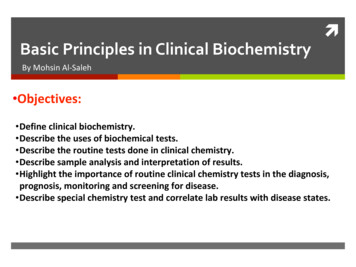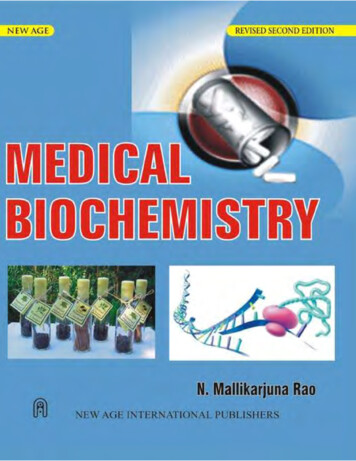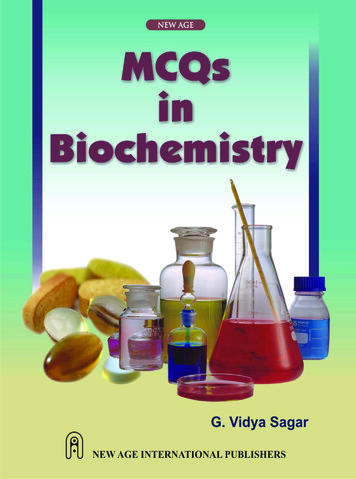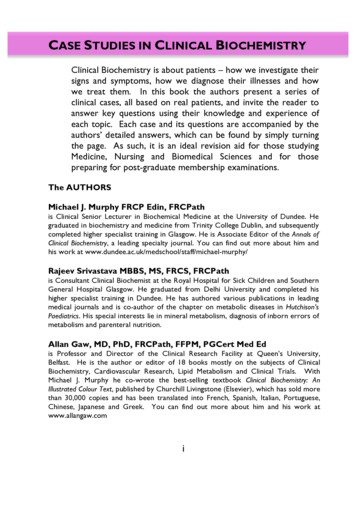
Transcription
BASIC CONCEPTS INBIOCHEMISTRYA STUDENT'S SURVIVAL GUIDESecond EditionHIRAM F. GILBERT, Ph.D.Professor of BiochemistryBaylor College of MedicineHouston, TexasMcGraw-HillHealth Professions DivisionNew York St. Louis San FranciscoAuckland Bogotá Caracas Lisbon London MadridMexico City Milan Montreal New Delhi San JuanSingapore Sydney Tokyo Toronto
BASIC CONCEPTS IN BIOCHEMISTRY, 2/ECopyright 2000, 1992 by the McGraw-Hill Companies, Inc. Allrights reserved. Printed in the United States of America. Except as permitted under the United States Copyright Act of 1976, no part of thispublication may be reproduced or distributed in any form or by anymeans, or stored in a data base or retrieval system, without the priorwritten permission of the publisher.1234567890 DOCDOC 99ISBN 0-07-135657-6This book was set in Times Roman by Better Graphics, Inc. The editors were Steve Zollo and Barbara Holton; the production supervisorwas Richard Ruzycka; the index was prepared by Jerry Ralya. R. R.Donnelley and Sons was the printer and binder.This book is printed on acid-free paper.Cataloging-in-Publication Data is on file for this book at theLibrary of Congress.
PROLOGUE Basic Concepts in Biochemistry: A Student’s Survival Guide is not a conventional book: It is not a review book or a textbook or a problem book.It is a book that offers help in two different ways—help in understandingthe concepts of biochemistry and help in organizing your attack on thesubject and minimizing the subject’s attack on you.This book presents what are often viewed as the more difficult concepts in an introductory biochemistry course and describes them inenough detail and in simple enough language to make them understandable. We surveyed first- and second-year medical students at a nationalstudent meeting asking them to list, in order, the parts of biochemistrythey found most difficult to understand. The winner (or loser), by far, wasintegration of metabolism. Metabolic control, pH, and enzyme kineticsran closely behind, with notable mention given to molecular biology andproteins.Biochemistry texts and biochemistry professors are burdened withthe task of presenting facts, and the enormity of this task can get in theway of explaining concepts. Since I don’t feel burdened by that necessity,I’ve only outlined most of the facts and concentrated on concepts. Myrationale is that concepts are considerably easier to remember than factsand that concepts, if appropriately mastered, can minimize the amount ofmaterial that has to be memorized—you can just figure everything outwhen required. In Basic Concepts in Biochemistry, central concepts aredeveloped in a stepwise fashion. The simplest concepts provide a reviewof what might have been forgotten, and the more complex concepts present what might not have been realized. xv
CONTENTPrefacePrologueS xiiixvCHAPTER 1 WHERE TO STARTInstructionsWhat Do I Need to Know?Instructions for UseStudying and ExamsTrivia Sorter112224CHAPTER 2 PROTEIN STRUCTUREAmino Acid StructureInteractionsWaterHydrophobic Interactionvan der Waals Interactions and London Dispersion ForcesHydrogen BondsSecondary StructureProtein StabilityFavorable (Good) InteractionsUnfavorable (Bad) InteractionsTemperature-Sensitive MutationsLigand-Binding SpecificityGlobal Conclusion66899111112151717192021CHAPTER 3 MEMBRANES ANDMEMBRANE PROTEINSGeneral Membrane FunctionMembrane CompositionPhospholipid BilayerMembrane StructurePosttranslational ModificationMembrane FluidityDiffusion in MembranesMovement of Ions and Molecules Across Membranes222223242526272828v
vi Transport Across MembranesThe Nernst EquationContents2931CHAPTER 4 DNA-RNA STRUCTUREDNA StructureDNA StabilityRNA Secondary Structure35353738CHAPTER 5 EXPRESSION OF GENETICINFORMATIONInformation MetabolismDirections and ConventionsDNA ReplicationTypes of DNA PolymeraseRecombinationRegulation of Information MetabolismTranscriptionRegulation of TranscriptionTranslationUse of High-Energy Phosphate Bonds During Translation4040414245474953555760CHAPTER 6 RECOMBINANT-DNA METHODOLOGYRestriction AnalysisGels and ElectrophoresisBlottingRestriction Fragment-Length PolymorphismCloningSequencingMutagenesisPolymerase Chain Reaction616165676970737576CHAPTER 7 ENZYME MECHANISMActive SiteTransition StateCatalysisLock and KeyInduced FitNonproductive BindingEntropyStrain and Distortion808181838383858788
ContentsTransition-State StabilizationTransition-State AnalogsChemical Catalysis vii 889193CHAPTER 8 ENZYME KINETICSS, P, and E (Substrate, Product, Enzyme)Amounts and ConcentrationsActive SiteAssayVelocityInitial VelocityMechanismLittle k’sMichaelis-Menten EquationVmaxkcatKmSpecial Pointskcat/KmRate AccelerationsSteady-State ApproximationTransformations and GraphsInhibitionAllosterism and CooperativityThe Monod-Wyman-Changeaux 111112117119CHAPTER 9 SIGNAL TRANSDUCTION PATHWAYSSignal Transduction PathwaysOrganizationSignalsReceptorsSoluble ReceptorsTransmembrane ReceptorsEnzyme Coupled ReceptorsG-Protein Coupled ReceptorsIon-Channel Coupled ReceptorsSecond 125126126128128131132133136137138
viii ContentsCHAPTER 10 GLYCOLYSISAND GLUCONEOGENESISGlycolysis FunctionGlycolysis LocationGlycolysis ConnectionsGlycolysis RegulationGlycolysis ATP YieldsGlycolysis EquationsEffect of ArsenateLactate or PyruvateGluconeogenesis FunctionGluconeogenesis LocationGluconeogenesis ConnectionsGluconeogenesis RegulationGluconeogenesis ATP CostsGluconeogenesis 6146CHAPTER 11 GLYCOGEN SYNTHESISAND P YieldATP CostMolecular Features147147147148148150150150CHAPTER 12TCA Cycle153153TCA CYCLECHAPTER 13 FAT SYNTHESISAND DEGRADATIONFatty Acid Synthesis FunctionFatty Acid Synthesis LocationFatty Acid Synthesis ConnectionsFatty Acid Synthesis RegulationFatty Acid Synthesis ATP Costs (for C16)Fatty Acid Synthesis EquationElongation and DesaturationTriglyceride and Phospholipid Synthesis155156156157157157159160162
Contents -Oxidation Function -Oxidation LocationCarnitine Shuttle -Oxidation Connections -Oxidation Regulation -Oxidation ATP Yield -Oxidation Equation -Oxidation of Unsaturated Fatty Acids -Oxidation of Odd-Chain-Length Fatty Acids ix 164164164164164166167168172CHAPTER 14 ELECTRON TRANSPORTAND OXIDATIVE PHOSPHORYLATIONOxidation and ReductionThe Electron Transport ChainConnectionsRegulationP/O CHAPTER 15 PENTOSE PHOSPHATEPATHWAYPentose Phosphate Pathway183183CHAPTER 16 AMINO ACID METABOLISMNonessential Amino Acid SynthesisEssential Amino AcidsAmino Acid DegradationGeneralities of Amino Acid CatabolismProducts of Amino Acid Degradation186186187187187188CHAPTER 17 INTEGRATION OF ENERGYMETABOLISMIntegrating Metabolic PathwaysATPGlucoseStorage MoleculesMetabolic States and SignalsInsulin190191192192193194195
x ContentsGlucagonEpinephrineSecondary SignalsGeneralities of MetabolismPhosphorylationGlycogenMetabolic Movements of GlycogenFatMetabolic Movements of FatProteinMetabolic Movements of ProteinTissue CooperationLiverMuscleAdiposeBrainConnection of Storage PoolsFeedingFastingStarvationExcitementInterorgan CyclesCori CycleAlanine CycleKetone BodiesCHAPTER 18Urea CycleUREA 213213214214217219221221222223225225CHAPTER 19 PURINE METABOLISMPurine SynthesisPurine SalvageDeoxynucleotidesPurine Degradation227227228228229CHAPTER 20 PYRIMIDINE METABOLISMPyrimidine SynthesisPyrimidine SalvagePyrimidine Degradation230230231232
Contents xi CHAPTER 21 ONE-CARBON METABOLISMOne-Carbon MetabolismOxidation States of Carbon233233233CHAPTER 22 TRACKING CARBONSGlucose to PyruvateTCA Cycle236236238CHAPTER 23 ph, pKA, pROBLEMSProton: H or H3O AcidBaseNot All Acids and Bases Are Created EqualpKa log (Ka)Weak Acids Make Strong Bases (and Vice Versa)Who Gets the Proton?Don’t Forget StoichiometryThe Sadistic Little pTaking log10(x)Taking log10(x)pH log10 [H ]pKa log10 (Ka)BuffersHenderson-Hasselbalch EquationTitration CurvespI—Isoelectric PointThe Bicarbonate BufferImbalance in Blood pHAcidosis and 8248249250254255257258CHAPTER 24 THERMODYNAMICSAND KINETICSThermodynamicsFree EnergyAdding Free-Energy ChangesCoupling Free EnergiesThermodynamic Cycles G H T SDriving Force261261263268268269272273
xii ContentsKineticsVelocityTransition State TheoryRate ConstantsRate Constants and x319
PREFACE Since the first edition of this series, we have witnessed the birth of “molecular medicine,” using biochemistry, cell biology, and genetics to diagnose and treat disease. Consequently, the basic sciences are becomingmore important to the practice of medicine. This puts a new pressure onthe student—to understand the basis of molecular medicine and the molecular sciences. I still think that it’s easier to remember things that youunderstand, things that make sense. That’s the idea behind the BasicConcepts series and that’s why I have been so pleased with the expansionof the Basic Concepts series beyond Biochemistry.The revisions in the second edition include two new chapters,“Membranes and Membrane Proteins” and “Signal TransductionPathways.” These topics are related to the explosion of new informationabout cell signaling and signal transduction pathways. In addition, I’veadded some tables of information that I think will be helpful in seeing thebig picture (and remembering some of the more important details). Asbefore, the major topics and things to remember are set off in boxes so thatif you already know everything in the box, you can skip the rest of the section. xiii
CHAPTER 1 WHERE TO START InstructionsWhat Do I Need to Know?Instructions for UseStudying and ExamsTrivia Sorter INSTRUCTIONSRead for understanding. Read only what you don’t know. Organize,organize, organize.The first page of each chapter presents an index. A title-summary boxfor each section presents a short summary and memory jogger intendedto be helpful for review. If you already know what the boxed terms meanand feel comfortable with them, don’t bother to read the text section thatfollows—proceed until you find a heading you don’t understand, andthen read till you understand. The first rule (it may not really be the firstrule, but it is a rule) is not to waste time reading things you already know.Keep on not reading the text until you find something you don’tunderstand—then read the text till you do. The sections are generallyarranged in order of increasing complexity and build on previous sections. So if you screwed up and jumped in over your head, back up a section or two. Another option is just to look at the pictures. Pictures anddiagrams, if extensively annotated and carefully designed (by you), canbe an enormous review aid.1BG McGraw-Hill: Gilbert, Basic Concepts in Biochemistry, JN 5036
2 Basic Concepts in BiochemistryWHAT DO I NEED TO KNOW?You need to know only the things you will need later.Medicine and biology are becoming increasingly molecular innature, so one answer to the question is that you need to know thingsdown to the last atom. Everything is not the right answer. You can’t possibly learn it all. Therefore, you will have to be selective.Another answer is that you just need to know the things on the exam.Later ends at the final. In reality, later may be longer than this. Try topick out the major concepts of biochemistry as you go along. Conceptsare generally easier to remember than factual details—particularly if theconcepts make sense.INSTRUCTIONS FOR USEUnderstand the concepts first. Make notes. Never use a coloredhighlighter.General concepts don’t need to be memorized. Once you understandthem, they provide a framework to hang the rest of the material on. Sincethey don’t need to be memorized, they can be learned (or thought about)almost anywhere. To remember something, write it down. Don’t justhighlight it with a colored pen or pencil. Highlighting is a great way toforget to read the material.STUDYING AND EXAMSOrganize, understand, condense, memorize. 1. ALWAYS REMEMBER THAT IT IS POSSIBLE TO BE AWORTHWHILE HUMAN BEING REGARDLESS OF (OR IN SPITEOF) HOW MUCH BIOCHEMISTRY YOU KNOW. This won’t necessarily help you with biochemistry, but it may help you keep your sanity. 2. MINIMIZE THE AMOUNT OF MATERIAL THAT YOU HAVETO MEMORIZE. If you understand a general concept, you can oftenfigure out the specific details rather than memorize them. For example,BG McGraw-Hill: Gilbert, Basic Concepts in Biochemistry, JN 5036
1Where to Start 3 does phosphorylation activate or inactivate acetyl-CoA carboxylase? Youcould just memorize that it inactivates the enzyme. However, this wouldnot help when it came to the phosphorylation of glycogen synthase. Trythe following line of reasoning. We store energy after eating and retrieveit between meals. Storage and retrieval of energy do not happen at thesame time. Protein phosphorylation generally increases when you’re hungry. Since both acetyl-CoA carboxylase and glycogen synthase areinvolved in energy storage (fat and glucose, respectively), they will bothbe inactivated by phosphorylation. For just two enzymes, it might be easier to just memorize all the regulatory behaviors—but for several hundred? 3. ARRANGE NOTES AND STUDY TIME IN ORDER OF DECREASING IMPORTANCE. During the first (or even second andthird) pass, you can’t possibly learn everything biochemistry has to offer.Be selective. Learn the important (and general) things first. If you haveenough gray matter and time, then pack in the details. Organize yournotes the same way. For each topic (corresponding to about a chapter inmost texts) write down a short summary of the really important concepts(no more than one to two pages). Don’t write down the things that youalready know, just the things you’re likely to forget. Be really cryptic tosave space, and use lots of diagrams. These don’t have to be publicationquality diagrams; they only have to have meaning for you. The idea is tominimize the sheer volume of paper. You can’t find yourself at finalstime with a yellow-highlighted 1000-page text to review 2 days beforethe exam. An enormous amount of information can be crammed onto adiagram, and you learn a significant amount by creating diagrams. Usethem extensively. 4. SORT OUT THE TRIVIA AND FORGET ABOUT IT. The mostdifficult part may be deciding what the important things actually are.After all, if you’ve never had biochemistry, it all sounds important (ornone of it does). Use the following trivia sorter (or one of your owninvention) to help with these decisions. To use this sorter, you must firstset your trivia level. Your trivia level will depend on whether you justwant to pass or want to excel, whether you want to devote a lot of timeor a whole lot of time to biochemistry, and your prior experience. Onceyou set this level, make sure you know almost everything above this leveland ignore almost everything below it. Setting your trivia level is not irreversible; the setting can be moved at any time. You should consider levels 7 to 10 as the minimal acceptable trivia level (passing). The triviasorter shown here is generic. You can make your own depending on theexact demands of the course you’re taking. Levels 21 and 22 might betoo trivial for anybody to spend time learning (again, this is opinion).BG McGraw-Hill: Gilbert, Basic Concepts in Biochemistry, JN 5036
4 Basic Concepts in BiochemistryTRIVIA .19.20.21.22.Purpose of a pathway—what’s the overall function?Names of molecules going into and coming out of the pathwayHow the pathway fits in with other pathwaysGeneral metabolic conditions under which the pathway isstimulated or inhibitedIdentity (by name) of control points—which steps of the pathway are regulated?Identity (by name) of general regulatory molecules and thedirection in which they push the metabolic pathwayNames of reactants and products for each regulated enzymeand each enzyme making or using ATP equivalentsNames of molecules in the pathway and how they’re connectedStructural features that are important for the function of specific molecules in the pathway (this includes DNA and proteins)Techniques in biochemistry, the way they work, and whatthey tell youMolecular basis for the interactions between moleculesGenetic diseases and/or specific drugs that affect the pathwayEssential vitamins and cofactors involved in the pathwaypHEnzyme kineticsSpecific molecules that inhibit or activate specific enzymesNames of individual reactants and products for nonregulatedstepsChemical structures (ability to recognize, not draw)Structures of individual reactants and products for allenzymes in pathwayReaction mechanism (chemistry) for a specific enzymeCleavage specificity for proteases or restriction endonucleasesMolecular weights and quaternary structures 5. DON’T WASTE TIME ON ABSOLUTE TRIVIA UNLESS YOUHAVE THE TIME TO WASTE. It is possible to decide that somethingis just not worth remembering; for example, cleavage specificities of proteases or restriction endonucleases, and protein molecular weights, areBG McGraw-Hill: Gilbert, Basic Concepts in Biochemistry, JN 5036
1Where to Start 5 obvious choices. You can set the “too trivial to bear” level anywhere youwant. You could decide that glycolysis is just not worth knowing. However, if you set your limits totally in the wrong place, you will get anotherchance to figure this out when you repeat the course. The trivia line isan important line to draw, so think about your specific situation and therequirements of the course before you draw it.BG McGraw-Hill: Gilbert, Basic Concepts in Biochemistry, JN 5036
CHAPTER 2 PROTEIN STRUCTURE Amino Acid StructureInteractionsWaterHydrophobic InteractionVan der Waals Interactions and London Dispersion ForcesHydrogen BondsSecondary StructureProtein StabilityFavorable (Good) InteractionsUnfavorable (Bad) InteractionsTemperature-Sensitive MutationsLigand-Binding SpecificityGlobal Conclusion Proteins start out life as a bunch of amino acids linked together in a headto-tail fashion—the primary sequence. The one-dimensional informationcontained in the primary amino acid sequence of cellular proteins isenough to guide a protein into its three-dimensional structure, to determine its specificity for interaction with other molecules, to determine itsability to function as an enzyme, and to set its stability and lifetime.AMINO ACID STRUCTURERemember a few of the amino acids by functional groups. The restare hydrophobic.6BG McGraw-Hill: Gilbert, Basic Concepts in Biochemistry, JN 5036
2 Protein Structure7 Remembering something about the structures of the amino acids isjust one to those basic language things that must be dealt with since itcrops up over and over again—not only in protein structure but later inmetabolism. You need to get to the point that when you see Asp youdon’t think snake but see a negative charge. Don’t memorize the aminoacids down to the last atom, and don’t spend too much time worryingabout whether glycine is polar or nonpolar. Methylene groups (–CH2–)may be important, but keeping track of them on an individual basis isjust too much to ask. Organize the amino acids based on the functionalgroup of the side chain. Having an idea about functional groups of aminoacids will also help when you get to the biosynthesis and catabolism ofamino acids. Might as well bite the bullet early.HYDROPHILIC (POLAR) CHARGED POLAR Acidic (–COO ) and basic (–NH 3) amino acidside chains have a charge at neutral pH and strongly “prefer” to be onthe exterior, exposed to water, rather than in the interior of the protein.The terms acidic and basic for residues may seem a little strange. Aspand Glu are called acidic amino acids, although at neutral pH in mostproteins, Asp and Glu are not present in the acidic form (–COOH) butare present in the basic form (–COO ). So the acidic amino acids, Aspand Glu, are really bases (proton acceptors). The reason that Asp and Gluare called acidic residues is that they are such strong acids (protondonors) they have already lost their protons. Lys, Arg, and His are considered basic amino acids, even though they have a proton at neutral pH.The same argument applies: Lys, Arg, and His are such good bases (proton acceptors) that they have already picked up a proton at neutral pH.FUNCTIONAL drophilic, PolarCarboxylates—COO Amines—NH 3Amides—CONH2Alcohols—OHThiol—SHHydrophobic, Apolar—CH2—C RingsAMINO ACIDAsp, GluLys, Arg, HisAsn, GlnSer, Thr, TyrCysAla, Val, Leu, Ile, MetPhe, Trp, TyrPro, GlyBG McGraw-Hill: Gilbert, Basic Concepts in Biochemistry, JN 5036
8 Basic Concepts in BiochemistryCharged groups are usually found on the surface of proteins. It isvery difficult to remove a charged residue from the surface of a proteinand place it in the hydrophobic interior, where the dielectric constant islow. On the surface of the protein, a charged residue can be solvated bywater, and it is easy to separate oppositely charged ions because of thehigh dielectric constant of water.1 If a charged group is found in the interior of the protein, it is usually paired with a residue of the oppositecharge. This is termed a salt bridge. NEUTRAL POLAR These side chains are uncharged, but they havegroups (–OH, –SH, NH, C“O) that can hydrogen-bond to water. In anunfolded protein, these residues are hydrogen-bonded to water. They prefer to be exposed to water, but if they are found in the protein interiorthey are hydrogen-bonded to other polar groups.HYDROPHOBIC (APOLAR)Hydrocarbons (both aromatic and aliphatic) do not have many (or any)groups that can participate in the hydrogen-bonding network of water.They’re greasy and prefer to be on the interior of proteins (away fromwater). Note that a couple of the aromatics, Tyr and Trp, have O and N,and Met has an S, but these amino acids are still pretty hydrophobic. Thehydrophobic nature usually dominates; however, the O, N, and S atomsoften participate in hydrogen bonds in the interior of the protein.INTERACTIONSA few basic interactions are responsible for holding proteinstogether. The properties of water are intimately involved in theseinteractions.1The dielectric constant is a fundamental and obscure property of matter that puts a number on how hard it is to separate charged particles or groups when they’re in this material.In water, charge is easy to separate (water has a high dielectric constant). The charge distribution on water is uneven. It has a more positive end (H) and a more negative end (O)that can surround the charged group and align to balance the charge of an ion in water. Thisdipolar nature of water makes it easy for it to dissolve ionic material. Organic solvents likebenzene or octane have a low dielectric constant and a more uniform distribution of electrons. They do not have polar regions to interact with ions. In these types of solvents, justas in the interior of a protein, it is very difficult to separate two oppositely charged residues.BG McGraw-Hill: Gilbert, Basic Concepts in Biochemistry, JN 5036
2Protein Structure 9 WATERWater’s important. Polar amino acid chains can participate inhydrogen bonding to water, or hydrophobic side chains can interfere with it.The properties of water dominate the way we think about the interactions of biological molecules. That’s why many texts start with alengthy, but boring, discussion of water structure, and that’s why youprobably do need to read it.Basically, water is a polar molecule. The H—O bond is polarized—the H end is more positive than the O end. This polarity is reinforced bythe other H—O bond. Because of the polarity difference, water is both ahydrogen-bond donor and a hydrogen-bond acceptor. The two hydrogenscan each enter into hydrogen bonds with an appropriate acceptor, and thetwo lone pairs of electrons on oxygen can act as hydrogen-bond acceptors. Because of the multiple hydrogen-bond donor and acceptor sites,water interacts with itself. Water does two important things: It squeezesout oily stuff because the oily stuff interferes with the interaction of waterwith itself, and it interacts favorably with anything that can enter into itshydrogen-bonding network.HYDROPHOBIC INTERACTIONProteins fold in order to put as much of the greasy stuff out of contact with water as possible. This provides much of the “drivingforce” for protein folding, protein–protein interactions, and protein–ligand interactions (Fig. 2-1).The driving force for a chemical reaction is what makes it happen.It’s the interaction that contributes the most to the decrease in freeenergy. For protein (and DNA) folding, it’s the hydrophobic interactionthat provides most of the driving force. As water squeezes out thehydrophobic side chains, distant parts of the protein are brought togetherinto a compact structure. The hydrophobic core of most globular proteinsis very compact, and the pieces of the hydrophobic core must fit togetherrather precisely.BG McGraw-Hill: Gilbert, Basic Concepts in Biochemistry, JN 5036
10 Basic Concepts in BiochemistryORGANIZEDWATERA ORGANIZEDWATERBlarger total surface areaper total volumeA-BDISORGANIZEDWATER smaller surface areafor total volumeFigure 2-1 The Hydrophobic InteractionAs hydrophobic surfaces contact each other, the ordered water molecules thatoccupied the surfaces are liberated to go about their normal business. Theincreased entropy (disorder) of the water is favorable and drives (causes) theassociation of the hydrophobic surfaces.Putting a hydrophobic group into water is difficult to do (unfavorable). Normally, water forms an extensive hydrogen-bonding networkwith itself. The water molecules are constantly on the move, breakingand making new hydrogen bonds with neighboring water molecules.Water has two hydrogen bond donors (the two H—O bonds) and twohydrogen bond acceptors (the two lone electron pairs on oxygen), so agiven water molecule can make hydrogen bonds with neighboring watermolecules in a large number of different ways and in a large number ofdifferent directions. When a hydrophobic molecule is dissolved in water,the water molecules next to the hydrophobic molecule can interact withother water molecules only in a direction away from the hydrophobicmolecule. The water molecules in contact with the hydrophobic groupbecome more organized. In this case, organization means restricting thenumber of ways that the water molecules can be arranged in space. Theincreased organization (restricted freedom) of water that occurs arounda hydrophobic molecule represents an unfavorable decrease in theentropy of water.2 In the absence of other factors, this increased organization (decreased entropy) of water causes hydrophobic molecules to beinsoluble.The surface area of a hydrophobic molecule determines how unfavorable the interaction between the molecule and water will be. The big2As with most desks and notebooks, disorder is the natural state. Order requires the input ofenergy. Reactions in which there is an increasing disorder are more favorable. Physical chemists(and sometimes others) use the word entropy instead of disorder. There’s a discussion ofentropy at the end of this book.BG McGraw-Hill: Gilbert, Basic Concepts in Biochemistry, JN 5036
2Protein Structure 11 ger the surface area, the larger the number of ordered water moleculesand the more unfavorable the interaction between water and thehydrophobic molecule. Bringing hydrophobic residues together minimizes the surface area directly exposed to water. Surface area dependson the square of the radius of a hydrophobic “droplet,” while volumedepends on the cube of the radius. By bringing two droplets together andcombining their volume into a single droplet of larger radius, the surfacearea of the combined, larger droplet is less than that of the original twodroplets. When the two droplets are joined together, some of the organized water molecules are freed to become “normal.” This increased disorder (entropy) of the liberated water molecules tends to forcehydrophobic molecules to associate with one another. The hydrophobicinteraction provides most of the favorable interactions that hold proteins(and DNA) together. For proteins, the consequence of the hydrophobicinteraction is a compact, hydrophobic core where hydrophobic sidechains are in contact with each other.VAN DER WAALS INTERACTIONS AND LONDONDISPERSION FORCESThese are very short-range interactions between atoms that occurwhen atoms are packed very closely to each other.When the hydrophobic effect brings atoms very close together, vander Waals interactions and London dispersion forces, which work onlyover very short distances, come into play. This brings things even closertogether and squeezes out the holes. The bottom line is a very compact,hydrophobic core in a protein with few holes.HYDROGEN BONDSHydrogen bonding means sharing a hydrogen atom between oneatom that has a hydrogen atom (donor) and another atom that hasa lone pair of electrons (acceptor):—C“O H2O H2O H—N— —C“O H—N— H2O H2OThe secondary structure observed in proteins is there to keep fromlosing hydrogen bonds.BG McGraw-Hill: Gilbert, Basic Concepts in Biochemistry, JN 5036
12 Basic Concepts in BiochemistryA hydrogen bond is an interaction between two groups in which aweakly acidic proton is shared (not totally donated) between a group thathas a proton (the donor) and a group that can accept a proton (the acceptor). Water can be both a hydrogen-bond donor and a hydrogen-bondacceptor. In an unfolded protein, the hydrogen-bond donors and acceptors make hydrogen bonds w
Basic Concepts in Biochemistry: A Student’s Survival Guideis not a con-ventional book: It is not a review book or a textbook or a problem book. It is a book that offers help in two different ways—help in understanding the concepts of biochemistry and help in organizing your attack o
